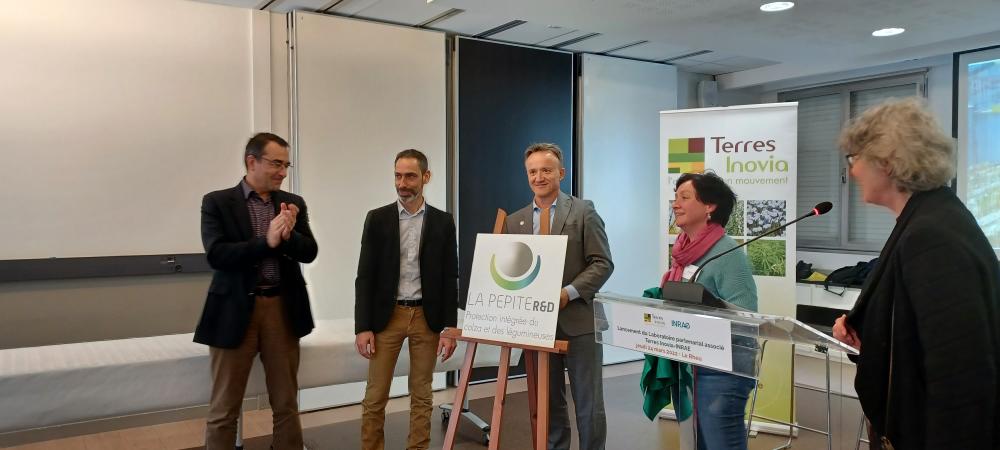Launch of LA PEPITE R&D | The INRAE - Terres Inovia partnership laboratory for the integrated protection of rapeseed and legumes
Launch of LA PEPITE R&D | The INRAE - Terres Inovia partnership laboratory for the integrated protection of rapeseed and legumes
Paris, 24 March 2022 - At a time when the challenges of food sovereignty and agro-ecological transition are more essential than ever, Terres Inovia, the technical institute of the vegetable oil and protein sector, and INRAE are pooling their know-how in an associated partnership laboratory dedicated to the research and development of high-performance, innovative and low-input crop systems. The two entities, which are highly complementary, have the mission of covering the entire crop protection chain, from research to the farmer's field. By combining the skills of 60 employees in genetics, pathology, entomology and ecology on the same site in Le Rheu (35), LA PEPITE R&D aims to improve the regularity of rapeseed and legume yields and to reduce the use of phytosanitary products.

Three major areas of intervention for the scientific programme of LA PEPITE R&D
Cultivated for production and diversification purposes, rapeseed and legumes face many challenges if they are to be produced in a sustainable manner. Based on the priority questions and issues of the moment, three areas of work have been defined to best meet the objectives set.
Better understanding of pests
In order to control pests, it is necessary to identify them (according to the different crops and geographical regions), but also to know their prevalence and their harmfulness to their host crops. Proposing effective deployment strategies requires describing the diversity of pathogen populations, understanding their determinants and their adaptation to host resistance. To this end, three directions of work have been defined:
- Putting the plot in its technical spatio-temporal context, i.e. describing and understanding the prevalence and harmfulness of pests and identifying the positive and negative interactions that influence different scales (regional and/or national).
- Enable optimal high-throughput epidemiosurveillance by making the best use of available knowledge and tools.
- Work on selection pressures and population adaptation to describe diversity and its dynamics at different scales, understand the evolutionary forces leading to population changes and adaptations, and draw consequences for risk management.
Creating multi-resistant varieties
The development of pest-resistant varieties remains a key lever in the fight against crop pests. As a challenge for technical institutes, the deployment of these varieties raises other questions and issues. Thus, the laboratory is working in four main areas:
- Knowledge of the variability of host response to pathogens and pests by identifying, for example, sources of resistance to be introduced into crop varieties to develop new, more resistant varieties.
- Evaluate the effectiveness and stability of resistance.
- Assess the impact of interactions between pests and between biotic or abiotic stresses.
- Integrate the genetic lever into a set of control methods.
Optimising the beneficial interactions of plants with their environment
Agroecology aims to design efficient production systems based on the optimisation of beneficial interactions between organisms and on plant diversification. The idea is to seek resilient cropping systems designed to limit outbreaks and epidemics, but also yield losses and the use of phytosanitary products. There are many levers to be mobilised to maximise the effect of interactions between crops. The work areas are divided as follows:
- Evaluate the impact of diversification on the biological control of pests. Indeed, quantifying the effects and determining the mechanisms is necessary to optimise services when designing systems or selecting varieties to best promote beneficial interactions.
- Define the spatial and temporal structuring of plant species that limit the impact of pests and favour their natural regulation, both at the plot and landscape level.
- Evaluate the risks of expanding areas cultivated in association in rotations and crop rotations. For each crop/bio-aggressor pairing, an analysis grid of practices will be established to trace the evolution of biotic risks, evaluate them and then identify levers to better limit them.